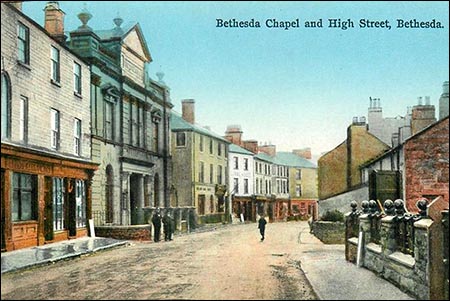Former Capel Bethesda, Bethesda
![]() Former Capel Bethesda, Bethesda
Former Capel Bethesda, Bethesda
 It’s because of this Independent chapel that the town is known as Bethesda today. Capel Bethesda was built in 1820, according to local historian Hugh Derfel Hughes in 1866. The other buildings in the vicinity were small cottages, including tyddynnod (crofts). The chapel was the dominant feature and people soon started referring to the village as Bethesda.
It’s because of this Independent chapel that the town is known as Bethesda today. Capel Bethesda was built in 1820, according to local historian Hugh Derfel Hughes in 1866. The other buildings in the vicinity were small cottages, including tyddynnod (crofts). The chapel was the dominant feature and people soon started referring to the village as Bethesda.
Many Welsh hamlets and villages are named after one of their chapels, such as Bethel, Carmel, Horeb, Penuel and Libanus. Most remained villages, but Bethesda became a town as the nearby Penrhyn quarry developed into one of the world’s largest slate quarries.
As the population grew, the chapel needed more capacity for worshippers. It was enlarged in 1840. The photo on the right (copyright: Gwynedd Archives Service) shows the chapel soon after its grand façade was installed in the early 1870s. Notice how the chapel dwarfed the neighbouring cottage. The photo below shows how the street had developed by the early 20th century.
 Many of the congregation were quarrymen, and the chapel experienced the effects of the great Penrhyn quarry strike of 1900-1903. In January 1903 a quarryman called Roberts, who had broken the strike and returned to work that week, arrived for Sunday evening service. As he entered he was jeered by a crowd outside and allegedly struck on the head. The deacon had to persuade others in the congregation not to walk out in protest at Roberts’ conduct. Roberts was escorted home from chapel by two constables, “followed for a short distance by a large crowd hooting and hissing”.
Many of the congregation were quarrymen, and the chapel experienced the effects of the great Penrhyn quarry strike of 1900-1903. In January 1903 a quarryman called Roberts, who had broken the strike and returned to work that week, arrived for Sunday evening service. As he entered he was jeered by a crowd outside and allegedly struck on the head. The deacon had to persuade others in the congregation not to walk out in protest at Roberts’ conduct. Roberts was escorted home from chapel by two constables, “followed for a short distance by a large crowd hooting and hissing”.
The chapel became derelict in the 1980s. In the late 1990s the North Wales Housing Association refurbished the building and reconfigured the interior as residential apartments. The building received the name Arafa Don, the title of a well-known song by the composer Richard Samuel Hughes, who lived nearby and was once the chapel’s organist.
With thanks to Prof Hywel Wyn-Owen, of the Welsh Place-Name Society, Hazel Pierce, John Llywelyn Williams, and Gwynedd Archives Service for the photo
Postcode: LL57 3AR View Location Map
Website of Gwynedd Archives Service

